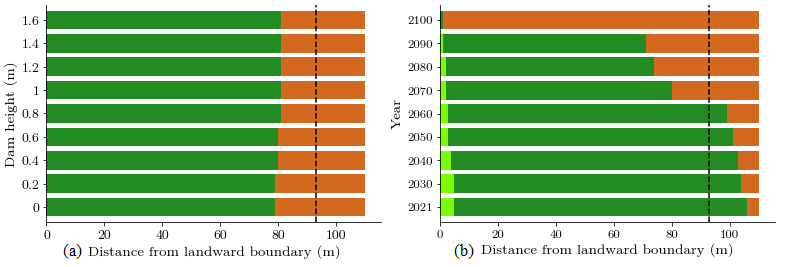T.R. Siegersma1,*, P.W.J.M. Willemsen1,2, E.M. Horstman1, Z. Hu3, B.W. Borsje1
1 University of Twente
2 Deltares
3 Sun Yat-Sen University
*corresponding author:
Introduction
In the era of ongoing sea level rise, Nature-based Solutions (NbS) that capture sediments and grow with rising sea level can be more cost-effective and sustainable compared to conventional coastal protection measures that are designed at a fixed height. Therefore, hybrid solutions including salt marshes in front of dikes are gaining ground. The challenge of predicting the outcomes of such NbS projects lies in the fact that relations between implemented management measures and the mechanisms that facilitate establishment of pioneer vegetation are largely unknown.
Methods
In this study we implement newly obtained monitoring data on the establishment of salt marsh pioneer vegetation in a dynamic equilibrium theory model for morphological salt marsh development (DET-ESTMORF) (Hu et al,, 2015). Vegetation growth of the pioneer species Salicornia was monitored during one growing season on a salt marsh (Marconi, Delfzijl, the Netherlands) that was constructed in 2018 by elevating the bed and implementing brushwood dams. By simultaneously measuring inundation and bed level change, thresholds for vegetation establishment were identified, which were used to extend DET-ESTMORF with the ability to simulate vegetation establishment. This extended model was then used to predict short- and long-term vegetation establishment in NbS under the influence of implemented management measures (brushwood dams and elevation of the bed level) and predicted sea level rise.
Results and conclusions
Model simulations showed that implementation of a brushwood dam on this specific salt marsh does not have a significant effect on the extent of vegetation coverage during one growing season (Figure 1a, green bars denote vegetation extent), because of the high bed level already present and consequently limited erosion. However, simulations showed that there is increased sedimentation landward of the dam compared to a no dam scenario, highlighting the adaptive capacity of the measure. Predicted sea level rise might result in an increasing retreat of the vegetation boundary the coming decades (Figure 1b). Furthermore, elevation of the salt marsh bed enhances vegetation establishment greatly as the vegetation boundary before the construction works in 2018 reaches only a distance of 5 m from the landward boundary (Figure 1b, light green bars).

Figure 1: (a) Extent of vegetation coverage (green bar) after one growing season for different dam heights (dam located at black dotted line). (b) Long-term establishment taking into account predicted sea level rise under the intermediate GHG emission scenario (7.6 mm year). Light green bars represent the predicted vegetation coverage before the bed was elevated in 2018 to facilitate salt marsh formation.
References
Hu, Z., Wang, Z. B., Zitman, T., Stive, M, Bouma, T. (2015). Predicting long-term and short-term tidal flat morphodynamics using a dynamic equilibrium theory. JGR: Earth Surface. 120.
I. Surname1*, F.N. Another-Surname2 , Y. Next-Surname2
1 University Name, Country; 2 Organization Name, Country
* Corresponding author: mail.name@organization.org


